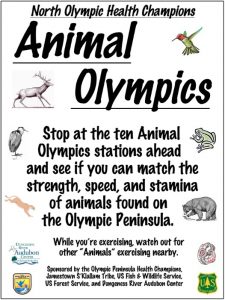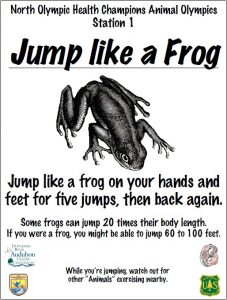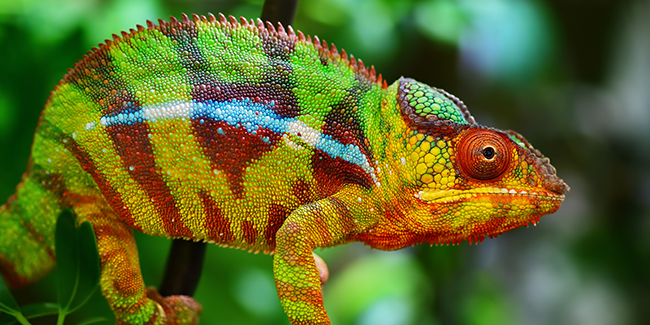Submitted by South Sound GREEN
In the face of COVID-19 and recent stay at home order, parents and guardians may find themselves looking for activities that not only keep students engaged, but also provide information about local environmental science and concerns. In our South Sound GREEN Home Based Science Project series, we will introduce and demonstrate various hands-on and at-home activities for children of all ages to do either indoors or outside!
 This time, we are going to talk about animal adaptations and how to have some fun while mimicking some unique activities of local wildlife!
This time, we are going to talk about animal adaptations and how to have some fun while mimicking some unique activities of local wildlife!
Animal Olympics
Grade Level: K-3
Materials:
- A large, open area where you can easily move and run around
Background
 It’s not always easy being an animal. If you’re a predator, you need to be fast and/or patient to be able to catch your food. If you’re prey, you need to have strategies to avoid, run away from, or withstand any potential attacks from hungry animals – and don’t forget about getting food yourself! Animals in the wild have adapted to their surrounding environment, including the other animals around them, to maximize their chance of survival.
It’s not always easy being an animal. If you’re a predator, you need to be fast and/or patient to be able to catch your food. If you’re prey, you need to have strategies to avoid, run away from, or withstand any potential attacks from hungry animals – and don’t forget about getting food yourself! Animals in the wild have adapted to their surrounding environment, including the other animals around them, to maximize their chance of survival.
In ecology, the study of living things and how they are related to each other and their environment, there is a concept known as niches. A niche is an animal’s role and position in the environment. This can include where the animal lives, what the animal eats, when the animal is awake or asleep, and a lot more. Too many animals trying to live within the same niche can lead to problems – for example, if too many animals are trying to eat the same plant, there will likely not be enough food to go around. Animals have adapted to fill separate niches from each other to be able to get the most resources available without needing to heavily compete with other animals.

In finding their own niches, animals develop different habits and actions that can seem silly from a human standpoint. However, these actions give animals necessary advantages in the wild and are perfectly natural. But what if you, a human, were to try to perform some of these animal actions? Do you think you’re up for the challenge?
Procedure
(Thanks to the Dungeness River Audubon Center, Jamestown/S’Klallum Tribe, US Forest Service and US Fish and Wildlife for the instructions and images):
- Welcome to the Animal Olympics! Feel free to dress up if you’d like – headbands, running sneakers, shirts with whatever region you’d like to represent, your choice!
- Round 1: Jump like a frog! Jump like a frog on your hands and feet for five jumps, then back again.

- Round 2: Balance like a squirrel! (this activity is done best using a sidewalk edge or another low beam – if you don’t have a beam to use, use a long line of string or tape!) Walk back and forth on a balance beam five times.
- Round 3: Flap like a hummingbird! Flap your arms rapidly 100 times.
- Round 4: Walk like a bear! Walk like a bear for 15 feet and back again.
- Round 5: Crawl like a crab! “Crab walk,” or walk upside-down on your hands and feet for 10 feet and back.
- Round 6: Stand like a heron! Stand on one leg like a roosting heron and count to 30. Switch legs and count to 30 again.
- Round 7: Pounce like a cougar! Hold a squatting position with legs bent for 15 seconds, then run 3 steps, then pounce.
- Round 8: Dip like a dipper! Stand in place and bend your knees 15 times with your arms in front of you.
- Round 9: Jump like a grasshopper! Long-jump from a standing position as far as you can five times.
- Round 10: Run like an elk! Sprint as fast as you can for 15 strides, then run back.
- You’re done! Take a celebratory picture!
- Bonus: What is your favorite animal? What adaptations do you think it has? Make up a new Animal Olympic activity based on your favorite animal!
Vocabulary
- Adaptation: Changes that living organisms make to better live and survive within their environment
- Ecology: The study of living things and how they are related to each other and their environment
- Niche: An animal’s role and position in the environment
Keep Learning!
- Learn cool facts about Washington State wildlife from the Washington Department of Fish and Wildlife
- Improve backyard/neighborhood habitat by building a Toad House
- Engineer a Hummingbird Feeder with materials you have at home
- Sneak a peak of wildlife in their own habitat using the National Park Service’s live web cams!
- Share pictures with us on Instagram! Use the hashtag #GREENfromhome or find us at @southsoundgreen.
South Sound GREEN (Global Rivers Environmental Education Network) is a watershed education program in Thurston County that educates, empowers and connects thousands of local students in watershed studies annually. Through South Sound GREEN, participants engage in science and engineering practices related to water quality in South Sound. For more information, visit southsoundgreen.org.



















































